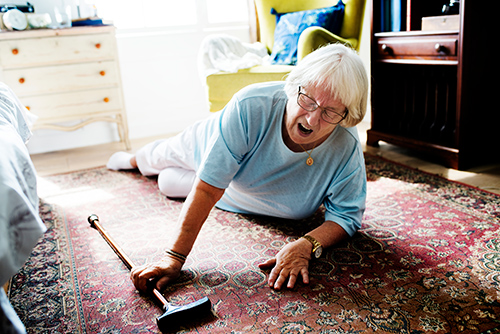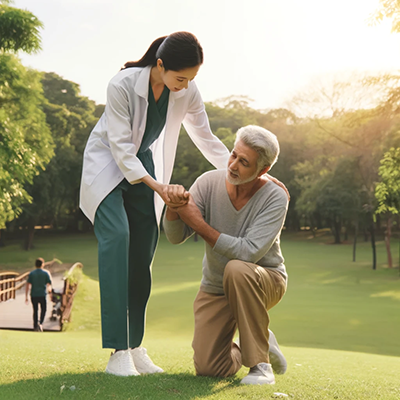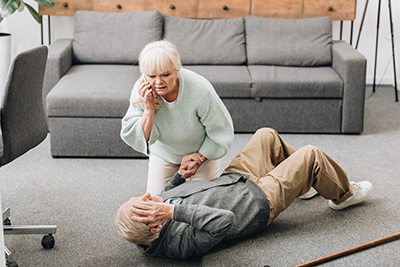Contents

Falling is an overall experience among the elderly. Millions of seniors worldwide fall each year, so many worry it may happen to them. This leads to injury-related visits to the doctor or, worse, suddenly dying from a falling accident.
The most common injuries resulting from falling are fractures (broken bones) and head and brain injuries. Most hip fractures are due to falling. It is likewise one of the leading causes of traumatic brain injuries. In the longer term, the likelihood of osteoporosis increases due to reduced weight-bearing activities during recovery.
As the mortality rate due to falling increases with age, certain risk factors and preventive measures can be identified to help mitigate the likelihood of dropping in the senior population.
Risk Factors for Falls Among the Elderly
Not all people who fall are clumsy or just have not been careful enough. However, several risk factors can make falling a significant cause for concern.
Lower Body Weakness
As the body ages, natural changes occur due to the cell’s evolutionary and biochemical reactions. These changes can cause lower body weakness, weaker muscles, and slower reaction times in preventing a fall.

Difficulty With Balance
By the time most individuals reach the age of sixty-five and above, they may find it harder to maintain balance. Age-related changes in the body and systems used to maintain balance become impaired. Many seniors depend on canes to keep their balance and minimize the likelihood of falling.
Vision Problems
Declining vision or eyesight is expected as a person ages, making it difficult to determine distance and see objects. Objects could seem closer or farther away than they are. This can make walking or moving alone a real difficulty and the risk of slipping or stumbling.
Home Hazards
Statistics show that two out of three falls happen at home. Certain things around the house, such as slippery surfaces, wet floors, electric cords and mats on the floor, uneven surfaces, and even poor lighting, contribute to potential hazards. All these hazards increase the risk of slipping and falling.
Medical Conditions
Many older adults have certain medical conditions that elevate their risk of falling. Conditions such as arthritis, diabetes, Alzheimer’s, and low blood pressure complicate mobility and speedy reaction time. Additionally, an older person who has fallen more than once within the last six months is likelier to fall again. These medical conditions and a history of falling could put a person at a higher risk of losing balance and falling again.
Preventing Falling Accidents
Older people are prone to tripping, stumbling, and falling due to the abovementioned risk factors. However, there are preventive measures that can help minimize these accidents from happening.
Doing Balance and Strength Exercises
As mentioned above, aging causes muscle weakness, making balance more difficult. Exercises that help strengthen the legs and improve balance are recommended to counter this. Activities such as ankle circles, knee extensions, calf raises, and sit-to-stand exercises are beneficial for balancing and strengthening the lower extremities.
Health and Vision Checks Regularly

Getting an annual check-up and seeking a doctor’s advice on potential health risks that may cause a fall is beneficial.
Have a Safer Home for Your Elderly Parents
Many falling incidents happen at home, meaning there are ways to make your home safer, especially if an older person lives with you.
These are a few ways to minimize any home hazards:
- Clear your floors of any potential hazards.
- Use non-slip mats on slippery floors, such as in the shower or the bathtub.
- Fit grab bars in the bathroom and shower areas.
- Make sure there are railings on both sides of the staircase.
- If possible, have older people sleep on the ground floor to minimize going up and down the staircase.
As with anything, deterrence is better than cure. So, wherever possible, be mindful of every situation and look at the potential for a hazard. Falls are dangerous to the elderly. They can decrease their comfort and mobility for the rest of their lives.
DISCLAIMER: All content on this website is presented solely for educational and informational objectives. Do not rely on the information provided as a replacement for advice, diagnosis, or treatment from a qualified medical expert. If you are pregnant, nursing, or have any preexisting medical concerns, talk to your doctor before using any herbal or natural medicines.
References
- Mayo Clinic Health System: https://www.mayoclinichealthsystem.org/hometown-health/speaking-of-health/falls-and-fall-prevention
- National Osteoporosis Foundation: https://www.bonehealthandosteoporosis.org/patients/treatment/calciumvitamin-d
